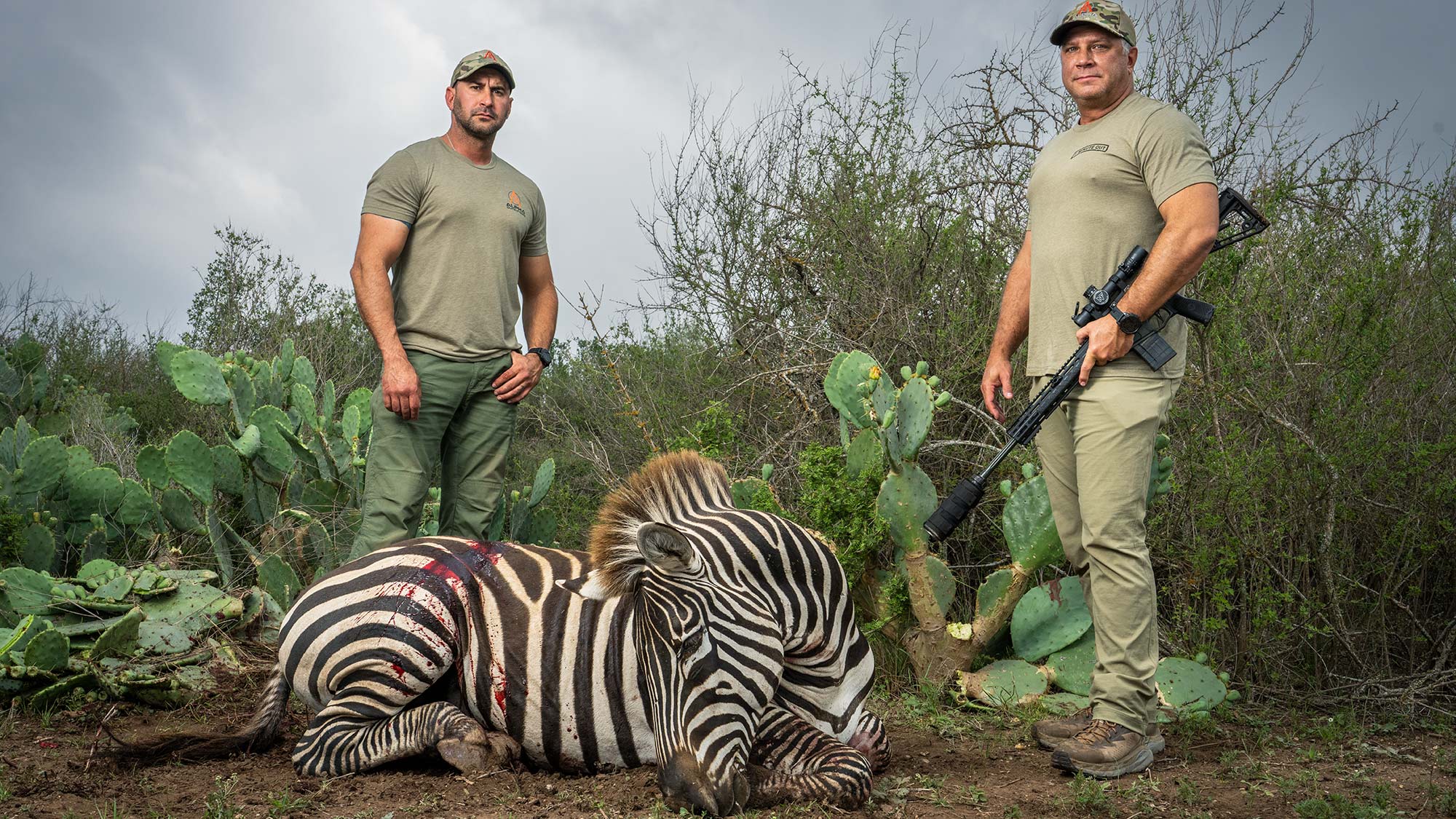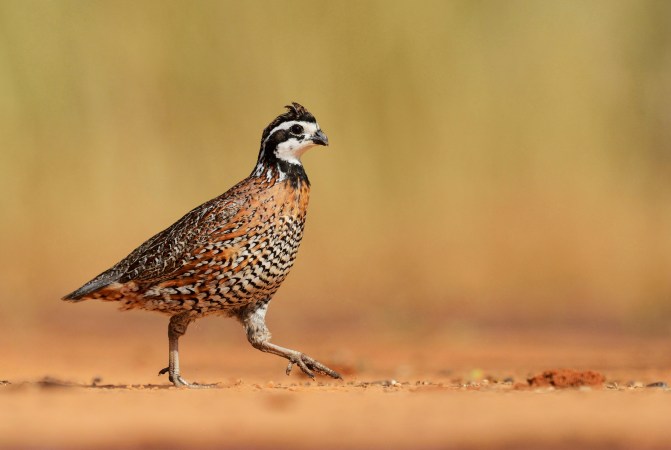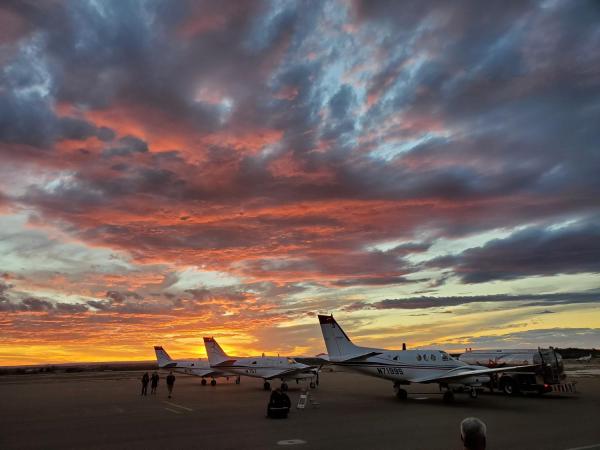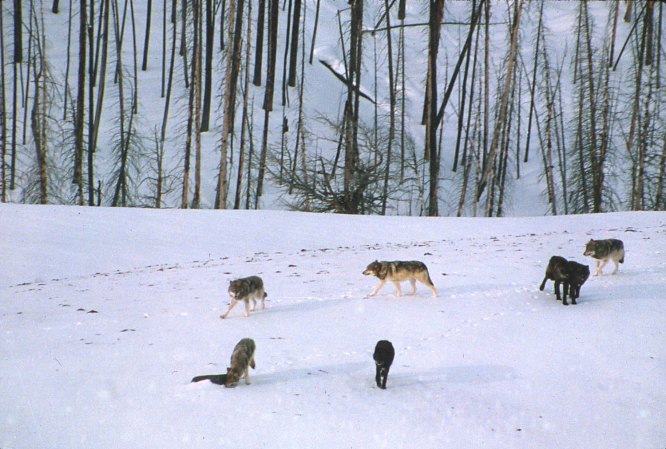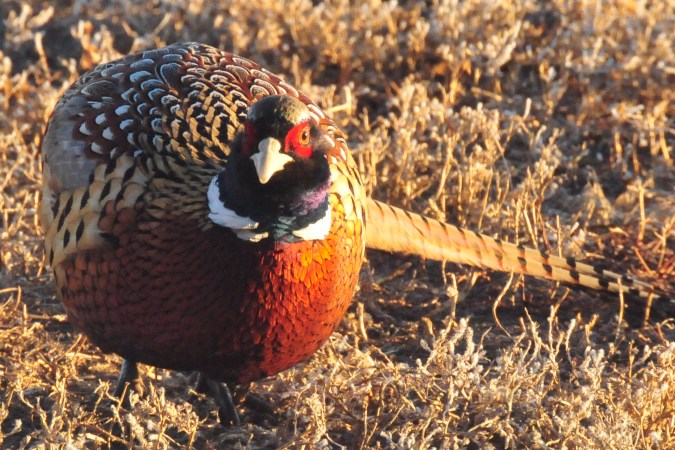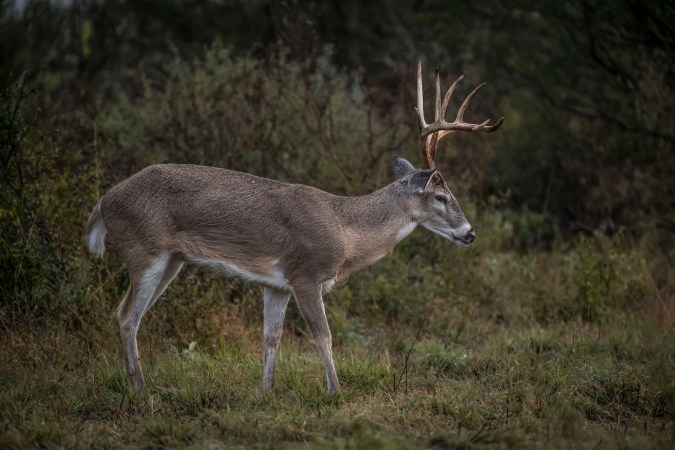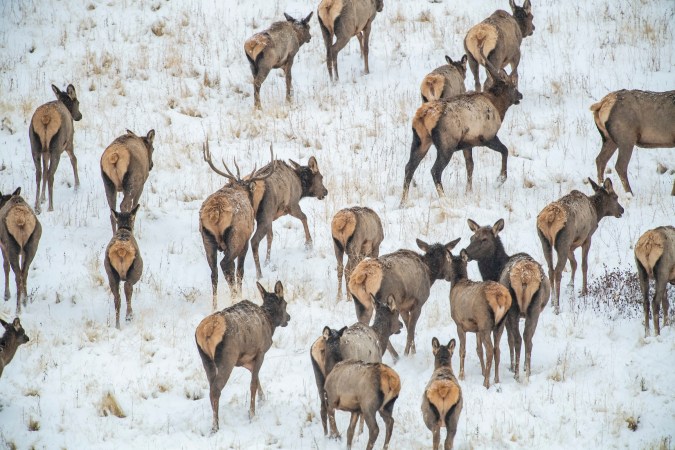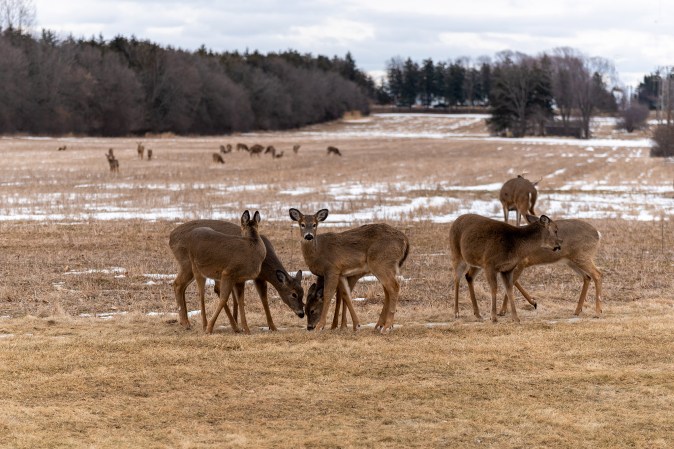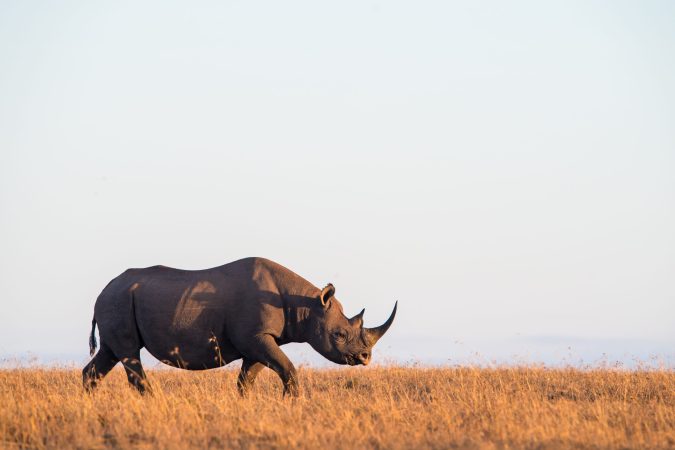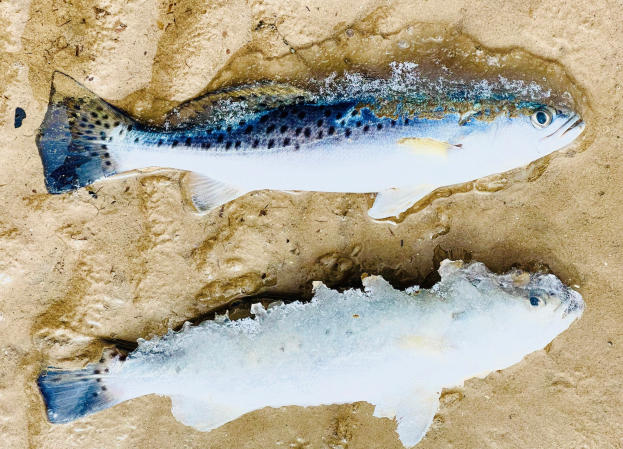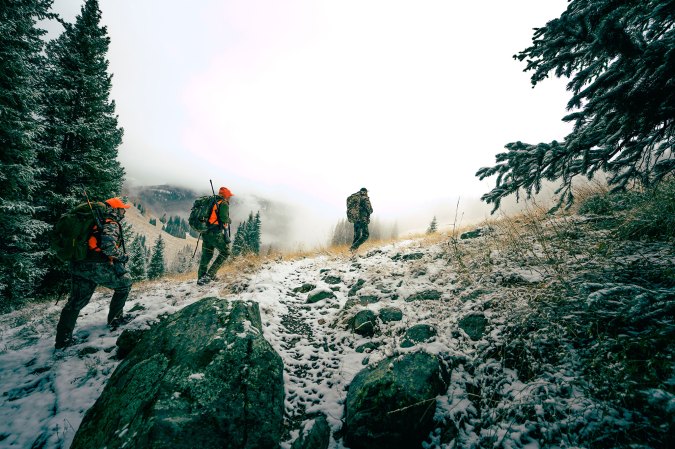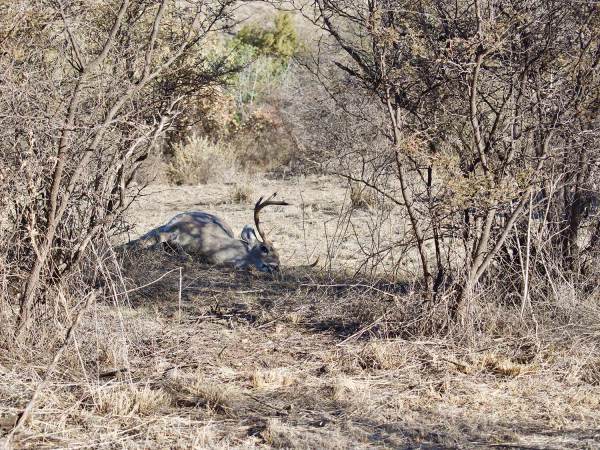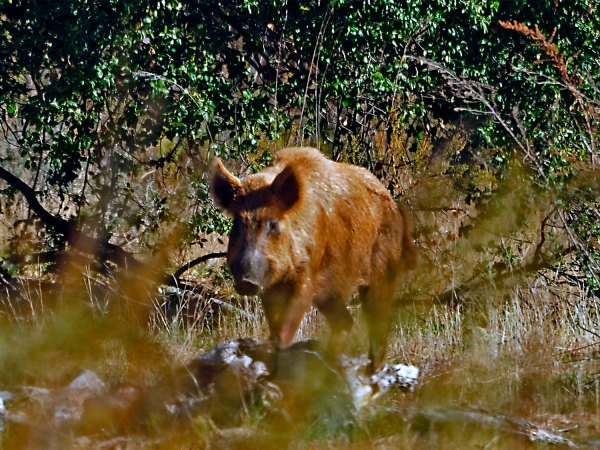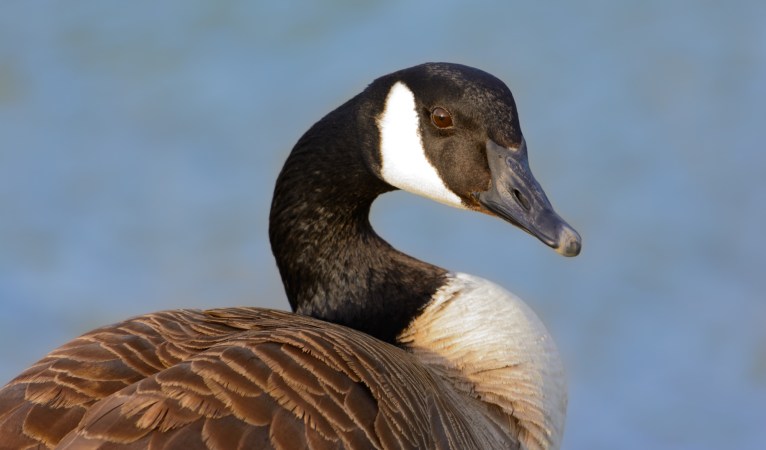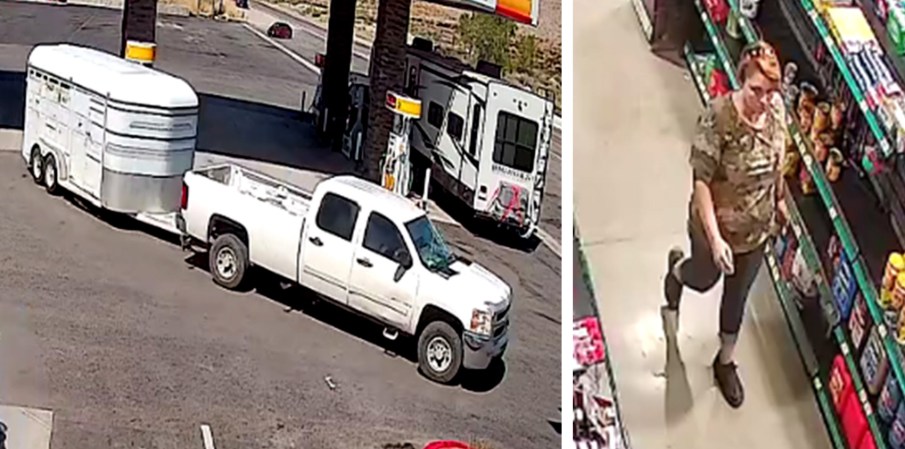IT’S A MUGGY SPRING DAY, and I’m riding on a bench mounted over the bed of an old Jeep — a typical rig in this part of the world. We’ve been looking for a broken-horned blackbuck for about an hour when I see one in a clearing with a group of Thomson’s gazelles.
“Broken horn, three o’clock,” I say quietly as four sets of binoculars turn to the right. The buck stands broadside, maybe 130 yards away, as the Jeep rolls to a stop.
Setting 9-year-old Landon up on the shooting sticks, Jason Wallace crouches over her left shoulder. To her right, her dad, Mike Bowen, whispers to shoot when she’s ready. But then the blackbuck trots off. The trio hops back in the Jeep, and away we go, driving along the dusty senderos of Salt Creek Ranch.
Located 50 miles north of the Mexican border, the 3,600-acre, high-fenced property holds 45 species of exotic wildlife. Wallace, who owns Alpha Outfitters and runs the operation here, tells me the ranch is home to roughly a thousand animals. The springbok, impala, and other antelope we see are bedded under mesquite trees and small oaks. Herds of wildebeest run in the open, galloping like wild horses. A lone kudu bull peeks over the pond, but by the time I spot his horns, he spooks.
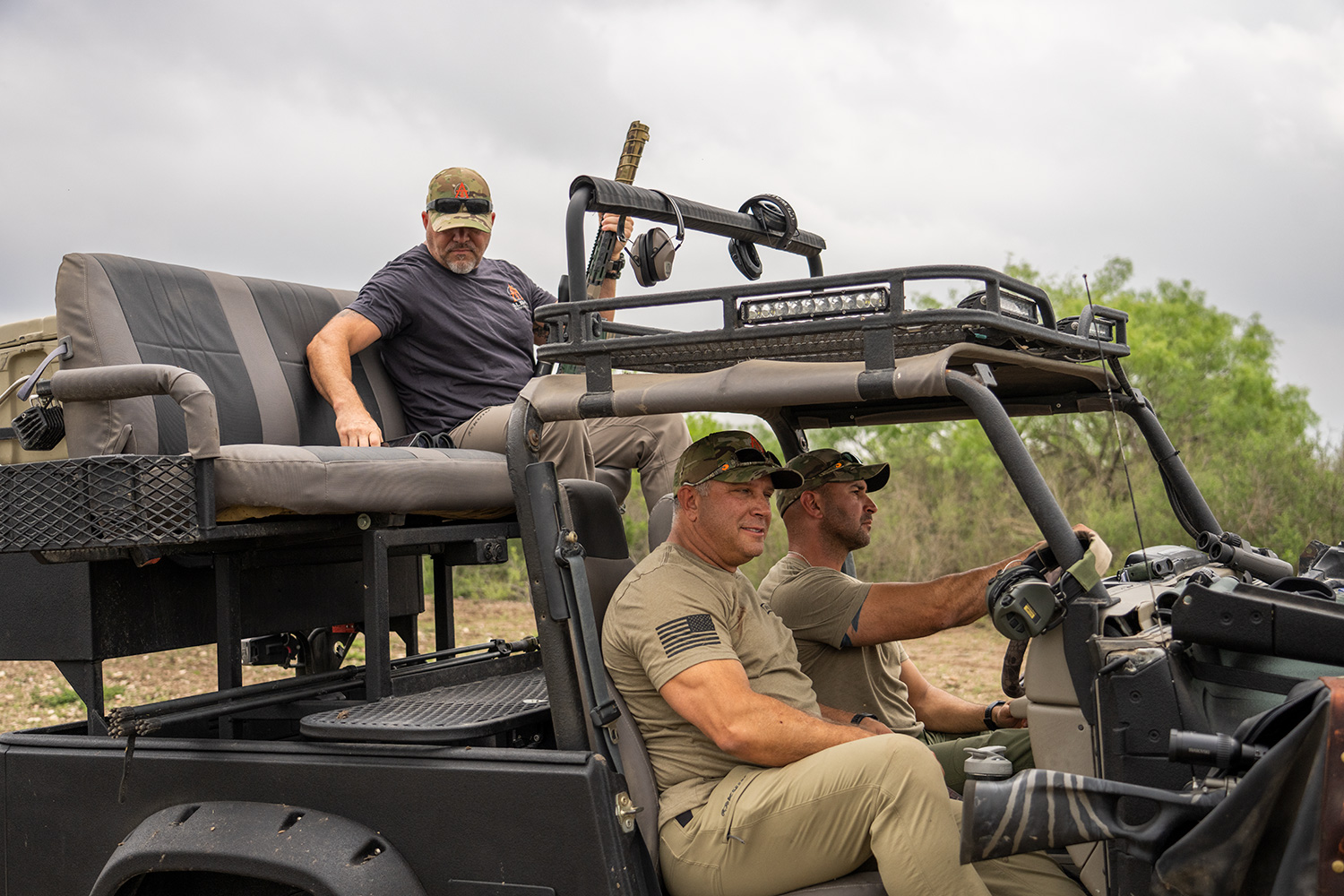
Turning uphill and out of the grasslands, I peer into the brush on either side of the road. I won’t spot a scimitar-horned oryx or a dama gazelle until this evening, but Wallace assures me they’re around. With the sun overhead, they’re just hiding in the thick stuff along with most of the other transplants.
“It’s crazy how well these animals can hide when they want to,” Wallace says from behind the wheel. “We’re talking about a mostly white 450-pound antelope, and one could be standing right over there, not 20 feet into the brush.”
Still, I have a better chance of seeing a scimitar oryx here than in the wilds of Africa, where the species is now extinct. It’s a paradox that defines the modern-day safari industry in Texas, where wealthy hunters pay tens of thousands of dollars to shoot exotic species behind high fences.
But as the potential for profit has grown, so has the industry’s role as a conservation tool. If things continue the way they’re going, then by the year 2100 or so, most safaris for African species will take place in the Lone Star State. Rising temperatures, poaching, and unchecked human development will leave parts of the Mother Continent unrecognizable, with scientists estimating that more than half its mammals will disappear by the end of the century.
For some of these exotic species, a high-fence ranch in Texas just might be their last chance at avoiding extinction. Many of the rare animals now being bred and raised in Texas could be used to repopulate their native homelands. In some places, this has already happened.
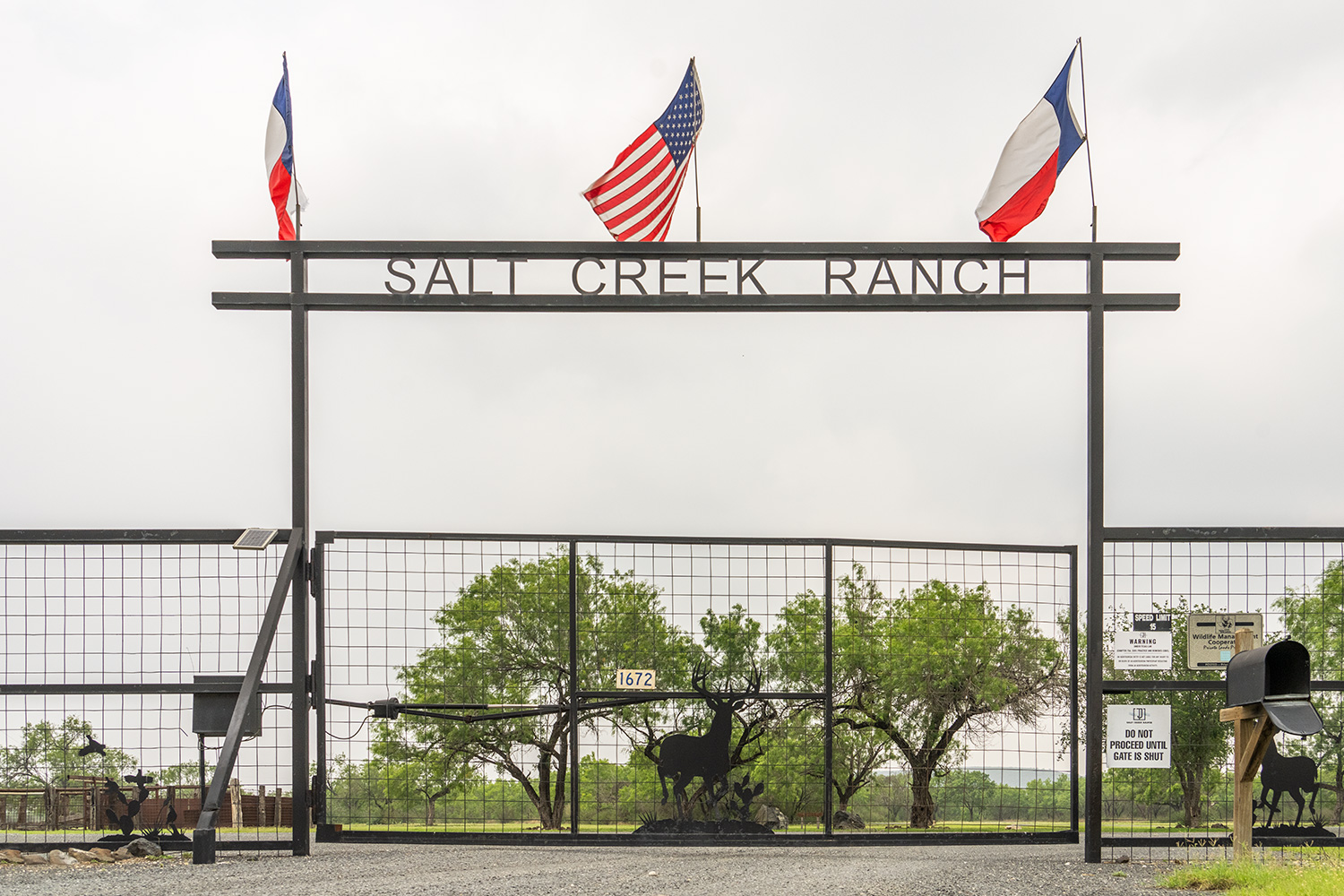
Conservation Through Commerce
The number of scimitar-horned oryx, addax antelope, and dama gazelle living in their native Africa had reached an all-time low in 2004, says Charly Seale, executive director of the state’s Exotic Wildlife Association. The three animals were added to the endangered species list, which automatically banned anyone from hunting them — regardless of whether the hunt took place in South Africa or South Texas. Foreseeing the financial hit that exotic-wildlife ranchers in Texas would take, the EWA invited representatives from the Department of the Interior to a well-known game preserve in Central Texas.
“We showed people what we were doing in this part of the Hill Country, and the vast number of scimitar, addax, and damas we had here,” Seale says. “They went back and rewrote parts of the Endangered Species Act to have [the three species] exempted, and George W. Bush signed off on it.”
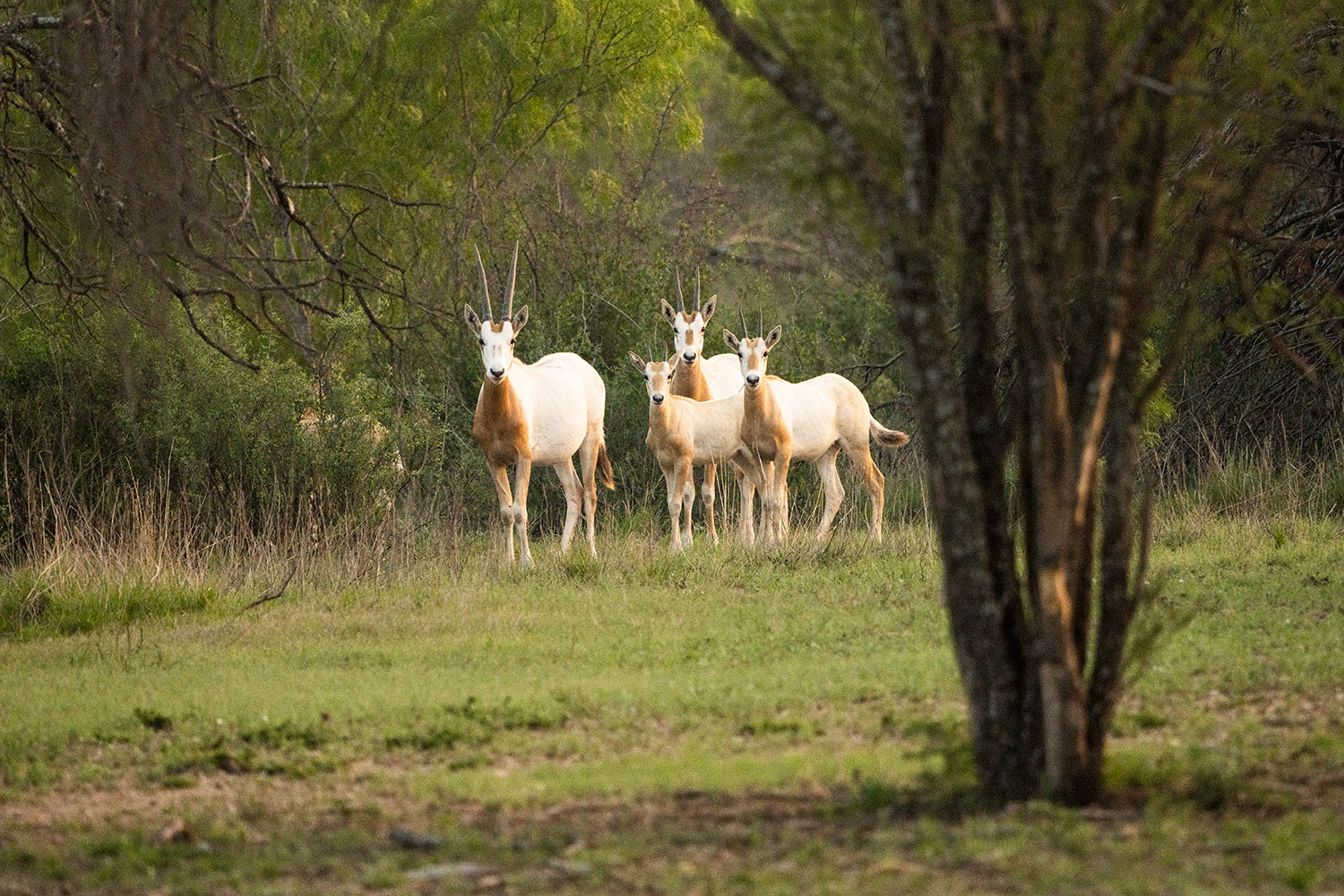
The Humane Society of the U.S. and other animal rights groups sued. And as the lawsuit dragged out over the next eight or so years, exotic-wildlife ranchers in Texas panicked. They started offloading these animals, selling them for pennies on the dollar.
Wallace, who was working for another landowner at the time, witnessed this practice firsthand.
“My boss said, ‘Jason, kill ’em all. I will not have an animal on my ranch that is a negative in my checkbook. If I can’t hunt these things, I don’t want them here. Lower the price and get rid of them.’ So we did.”
According to Seale’s estimates, the statewide populations of the three endangered species fell by at least 50 percent while the lawsuit languished in the courts. Then, in 2013, President Obama signed a bill into law that permanently exempted the species from the ESA and reopened the door to hunting scimitar oryx, addax antelope, and dama gazelle in Texas.
“That’s where we are today,” Seale says. “We’re back to freely raising, buying, selling, and hunting these animals. And we’re estimating the state’s current population of scimitar oryx to be somewhere in the neighborhood of 15 to 20 thousand.”
Meanwhile, the International Union for Conservation of Nature estimates that there are no more than 2,000 of the desert-dwelling antelope living in Africa, where they’re still classified as extinct in the wild. Most of these animals live on game preserves, which have been reinvigorated with stocks of Texas-raised scimitars over the years. Led by a partnership between the EWA and the Sahara Conservation Fund, a past reintroduction effort in Senegal embodies the organization’s motto: “conservation through commerce.”
“It’s very plain and simple: To conserve these animals, they have to have a value,” Seale says. “Each one of our ranchers is a small businessman, and at the end of every month, he’s gotta see a return on his investments or he won’t stay in business. But if we give these animals a value, they’ll flourish.”
The Future of Exotic Wildlife in Texas
The dama gazelle and addax antelope are still on shaky ground, with as few as 100 of each species living in the wild today. And although they number in the thousands on private Texas ranchland, Seale says that with the rare exception of the scimitar project in Senegal, reintroducing African animals raised in Texas is difficult because of political differences between the U.S. and various African governments.
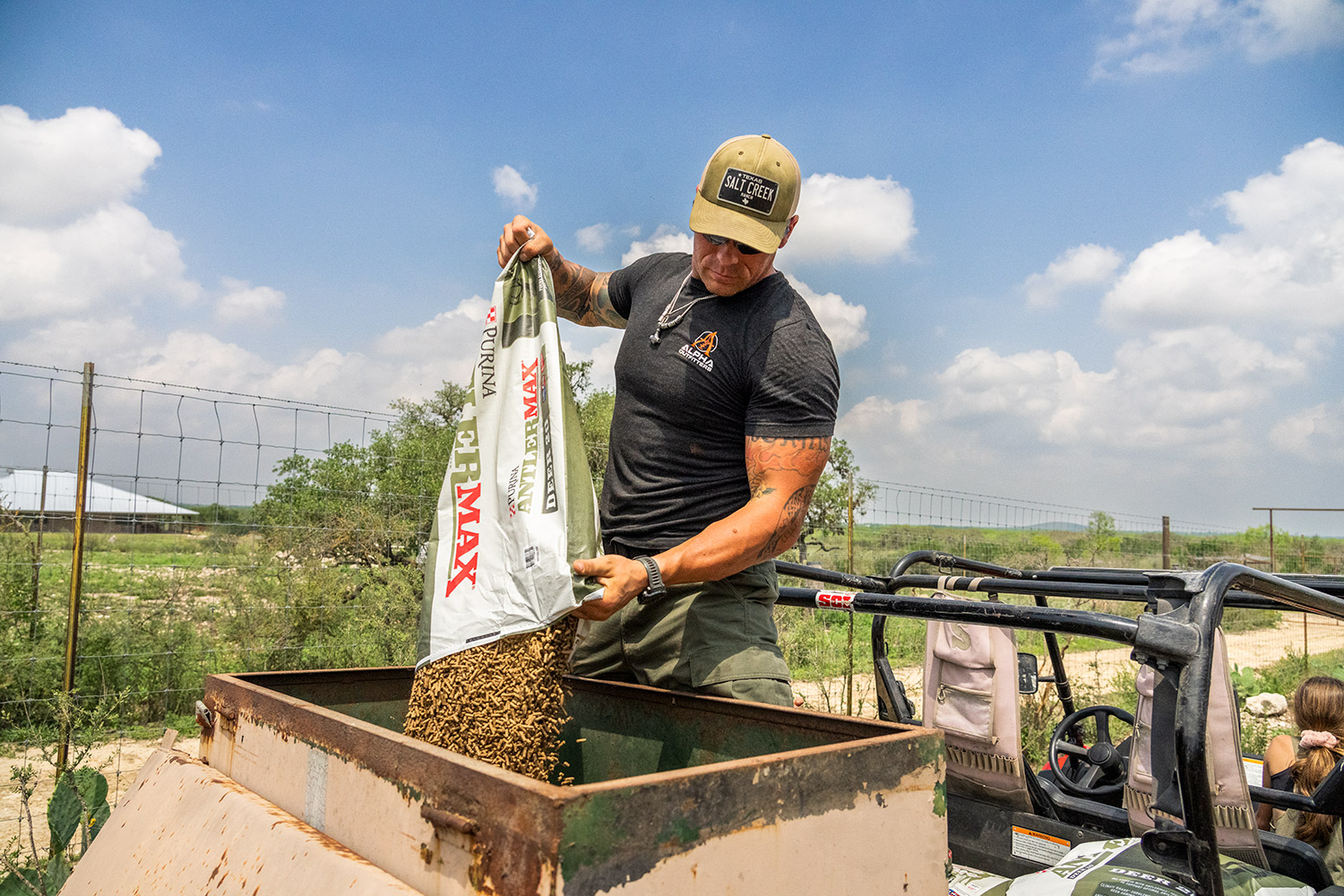
“We were involved in a project a few years ago called Rhino 1000,” Seale says. “Many South Africans wanted a safety deposit box, if you will, and they felt like Texas could be that box. Ranchers could raise the [rhinos] here, and then, eventually, we could repatriate their offspring back to South Africa. But as governments got more involved, South Africa put that plan on hiatus. And the whole idea just went away.”
Regardless, there are dozens of black and white rhinos sourced from U.S. zoos currently living on Texas ranches. (The total number of rhinos in the state does not appear to be published anywhere, and Seale says he’s unsure of the exact figure himself.) And because intense poaching pressure has brought the total number of wild black rhinos in Africa to around 6,000 animals, there’s still a chance these ranches could help with repopulation in the future.
Despite the red tape, partnerships between Texas conservationists and their counterparts in Africa are still being forged today, says Dr. James Derr, a researcher and professor at Texas A&M’s Department of Veterinary Pathobiology. A self-dubbed “old-school geneticist,” Derr has been taking graduate students to South Africa for more than 20 years.
“Many areas of South Africa, especially the Lowveld, are very, very similar to South Texas in terms of ecology,” he says, explaining why many of the African species do so well in the state. Both regions have a subtropical climate and open woodlands dominated by tall grasses and thorny scrub.
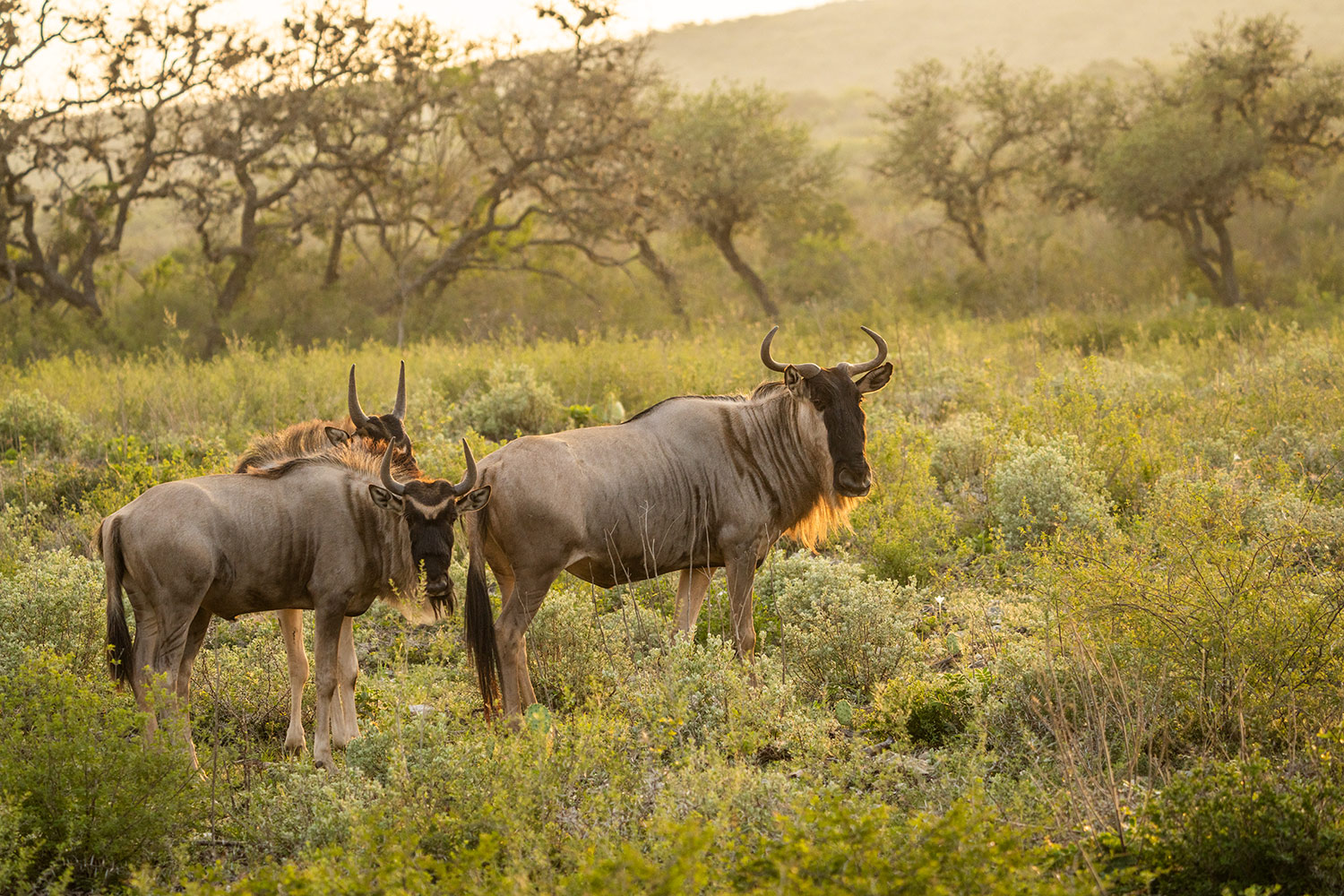
As the demand for exotic-wildlife professionals has grown over the past decade, Derr has helped launch a new program at A&M. He now brings veterinary students across the Atlantic, where they learn how to capture and care for African game.
“We teach them how to chemically immobilize African wildlife, and how to treat them, transport them, et cetera,” Derr says. “We’ll capture all the dangerous game species — elephants, rhinos, Cape buffalo, lions, and leopards — as well as plains game. That way, when they’re working as veterinarians here in Texas, they’ll know how to care for these exotic species that are all over the state now.”
Derr says he understands why the motivations behind the state’s exotic-hunting industry might be questioned by non-hunters and hunters alike. But the way he and some of his colleagues see it, the breeding programs on these ranches are now an integral part of a global conservation strategy.
“It’s not just exotic hoof stock,” says Dr. Brian Davis, an associate professor and researcher who studies population genetics at A&M. “I also work with a lot of large carnivores. And I think that captive animals — as long as they’re cared for properly — can represent genetic diversity that may not exist in the wild anymore. I think if certain wealthy individuals are committed to managing and maintaining these species, they can be an important, and maybe even an essential, part of conservation.”
High Dollars and High Fences
The first known release of exotic game on private land in Texas took place on the legendary King Ranch in the 1930s. After buying nilgai antelope from a zoo, which imported the stock straight from India, the owners of the sprawling cattle ranch released a small herd onto the coastal plain. The animals quickly adapted to the temperate climate and, with no natural predators, the herd grew.
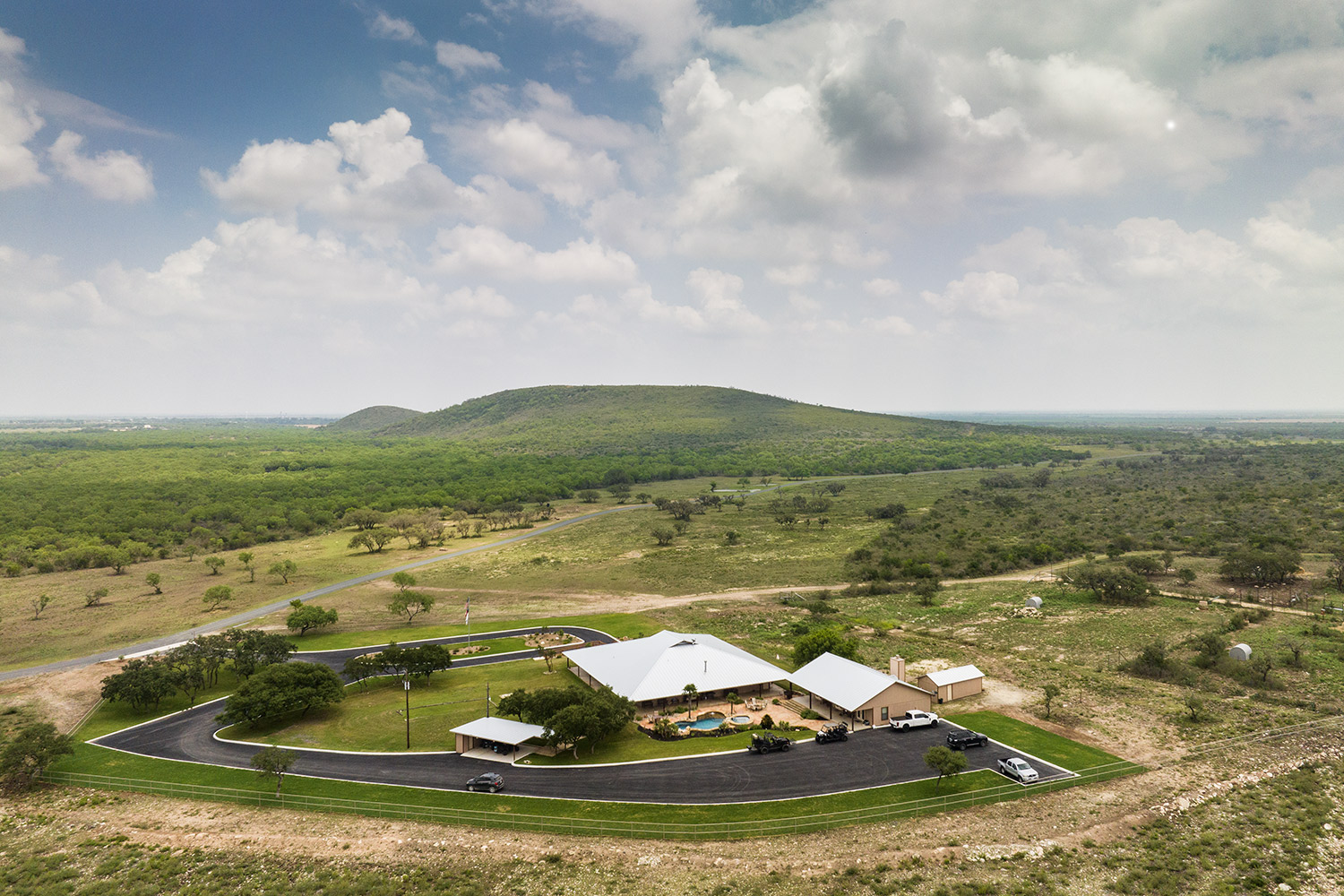
Other ranchers in Texas followed suit, stocking their places with blackbuck and axis purchased from big-city zoos. Then, roughly 20 years after the King Ranch release, Texas experienced its worst drought on record. Springs went dry and feed prices skyrocketed, crippling the state’s cattle ranchers.
“They were left with only one source of revenue, and that was their seasonal deer leases. So they started looking for alternative ways to provide a year-round income,” Seale explains. “Some of the old guys who started this whole industry had been to Africa and hunted over there. They saw that the climate and terrain were very similar to the Texas Hill Country and South Texas, and they figured those animals would flourish over here.”
The original ranchers argued that the animals should be classified as livestock and not wildlife, Seale says. “So they went to the legislature and got [a bill] passed that put [the animals] into the Texas agriculture code as livestock. And that’s where they remain today.”
By the time the EWA was founded, in 1967, the stage in Texas was set. The local landscape and climate had proven hospitable to these new species, and a lack of regulations had blurred the line between livestock and game animals. There was also money — a whole lot of money — to be made.
The state’s exotic-wildlife industry is currently valued at around $5 billion, which is double what it was six or seven years ago, according to Seale. He says there are roughly one million exotic animals now living on private game ranches in Texas. This includes only hoof stock — not birds or big cats, the latter of which require special permits to raise in pens.
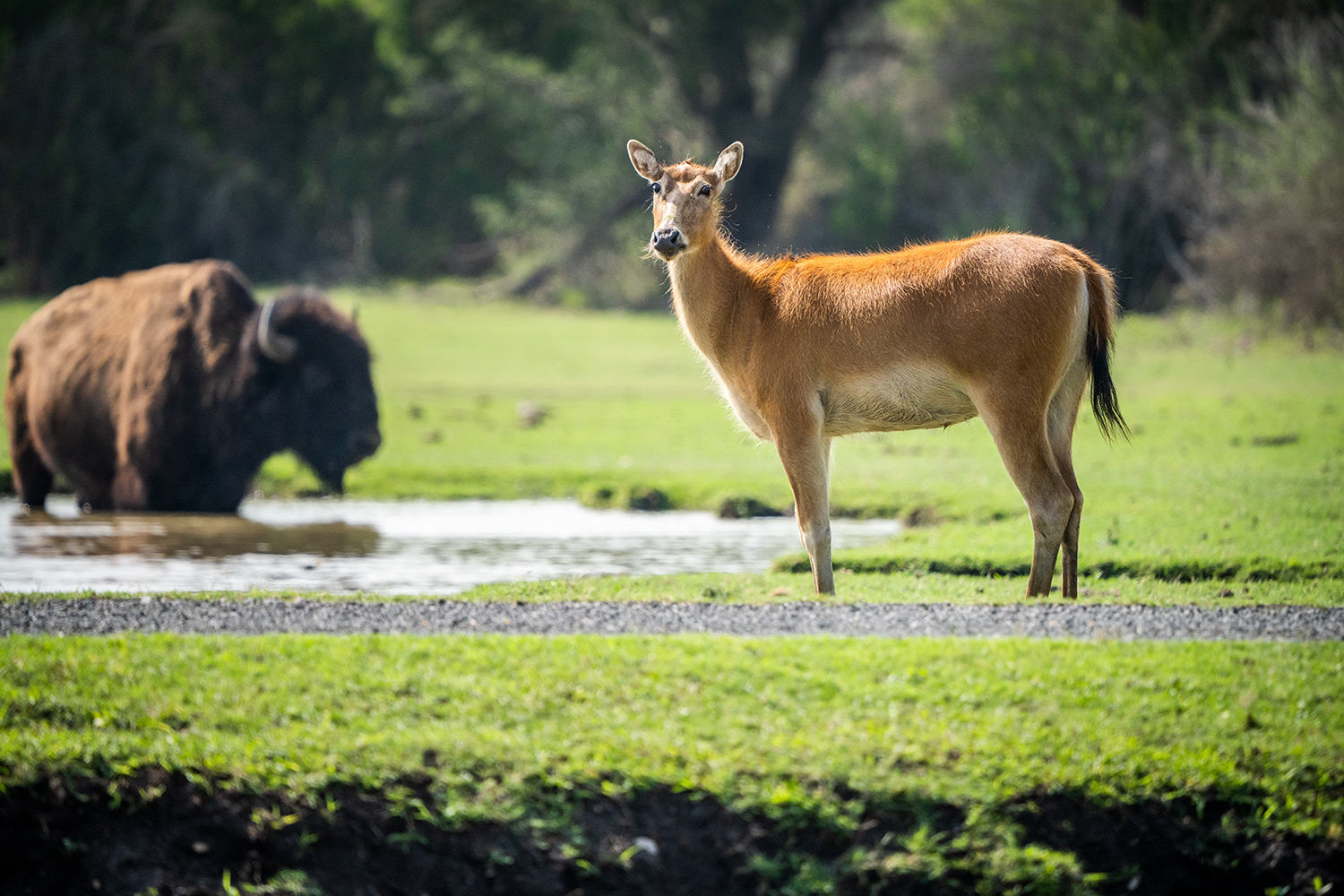
The state’s wildlife menagerie isn’t limited to African origins, either; animals from six continents have found a footing on private land here. Herds of Iberian ibex share the rocky hillsides with Himalayan tahr. Down in the oak savannas, Indian axis and blackbuck drink from stock tanks alongside red kangaroos and Père David’s deer from China. Standing in the right place on a crisp fall morning, a hunter can hear the roars of Patagonian red stag intermingled with the bugles of Rocky Mountain elk.
The Elephant in the Trophy Room
With the exception of rhinos and big cats, every one of the exotics held on private land in Texas can be hunted year-round at any time of day. And as long as the shooter possesses a valid Texas hunting license, there are few regulations on how these animals (which are, technically, livestock) can be hunted.
There are no bag limits or harvest restrictions. Hunting over bait and shooting from vehicles is permitted. The state doesn’t even have a minimum acreage law for hunting, although most counties require a minimum of 10 acres on which to legally hunt or discharge a firearm.
But is any of this really hunting? That depends who you ask and where you go. (Free-range exotics do exist in Texas, and several counties now have axis, nilgai, blackbuck, fallow deer, and aoudad, according to the Texas Parks and Wildlife Department.)
Wallace has dealt with plenty of critics who take issue with the way high-fence ranches like Salt Creek operate. “Zoo hunting,” they call it. But he thinks some of these critiques are overblown when you consider the vast acreage on some of these properties.
“Some of the [high-fence] ranches in Texas are bigger than small cities. You can drive the ranch for an entire day and never see the same fence,” Wallace says. “I don’t care what kind of ‘low fence’ or ‘no fence’ property you hunt. That animal will come to a boundary at some point — whether it’s an interstate, a river, or something else.”
Wallace also guides hunters in Namibia, and he points out that many of those hunting concessions have high fences, too.
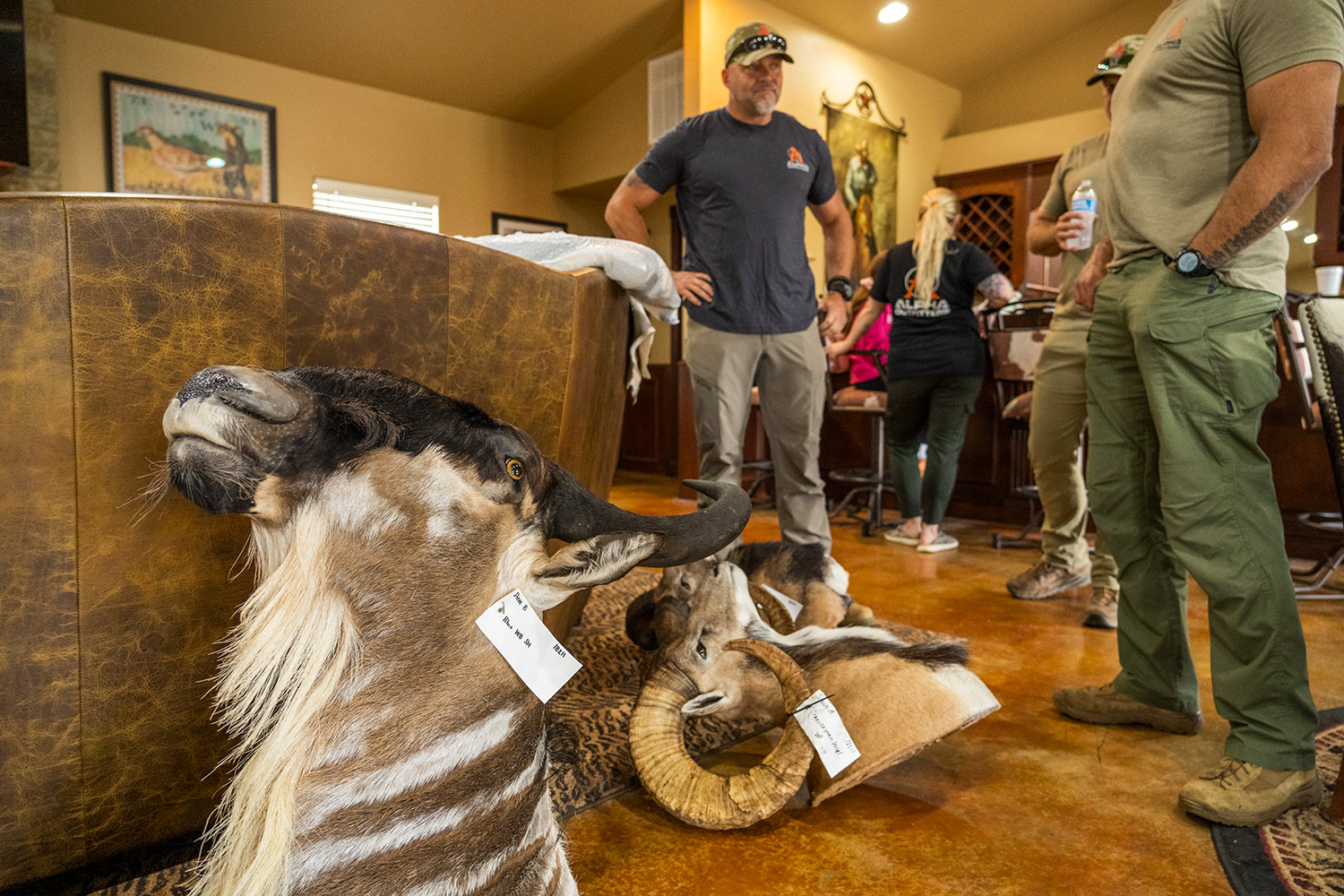
“Even those big ranches [in Africa] have high fences around their perimeters. They’re not to keep the animals from escaping. They’re to protect them from poachers,” he says. “But the kind of hunting we do there is exactly the same kind of hunting we do here.”
Regardless, this is where the Boone and Crockett Club and other big-game conservation organizations draw the line, as they don’t maintain records for pen-raised animals or critters killed behind high fences. An exception is Safari Club International, which fully supports high-fence hunting and accepts these animals into its own record book. (SCI declined to comment for this story.)
“There’s obviously a place and a market for it, but there is also a potential that this type of thing might be viewed negatively by the non-hunting public,” says B&C big game records director Justin Spring. “We’ve just always been a proponent of fair chase. And if you get to the root of that, ‘fair’ means the animal has an equal or greater chance to escape the hunter than the hunter does to kill it.”
Put plainly, on most high-fence hunts, the shooter gets their animal. And I’ll readily acknowledge that the kind of sheep hunting I saw take place at Salt Creek Ranch is not the kind that Jack O’Connor wrote about. Driving along a fence at the base of a large hill, we saw a band of Red sheep working their way through the scrub. Sitting in the passenger seat of the Jeep roughly 60 yards away, the client picked out the biggest one. Then he lifted his rifle and pulled the trigger. We found the ram piled up in the prickly pears a short distance from where it was hit.
Still, Spring sees Texas’ exotic-wildlife industry, and especially the breeding side, as having real value in the larger conservation world. He references B&C’s position statement on the genetic manipulation of game, which supports “the use of scientifically guided wildlife management techniques used to enhance or restore big game populations or at-risk species.”
Spring also points to the similarities between these exotic breeding programs and captive herds of desert bighorns, which Texas has released on public land over the years to strengthen native populations.
“I think it goes without saying,” he says, “that having these animals somewhere is better than not having them on the face of the earth.”
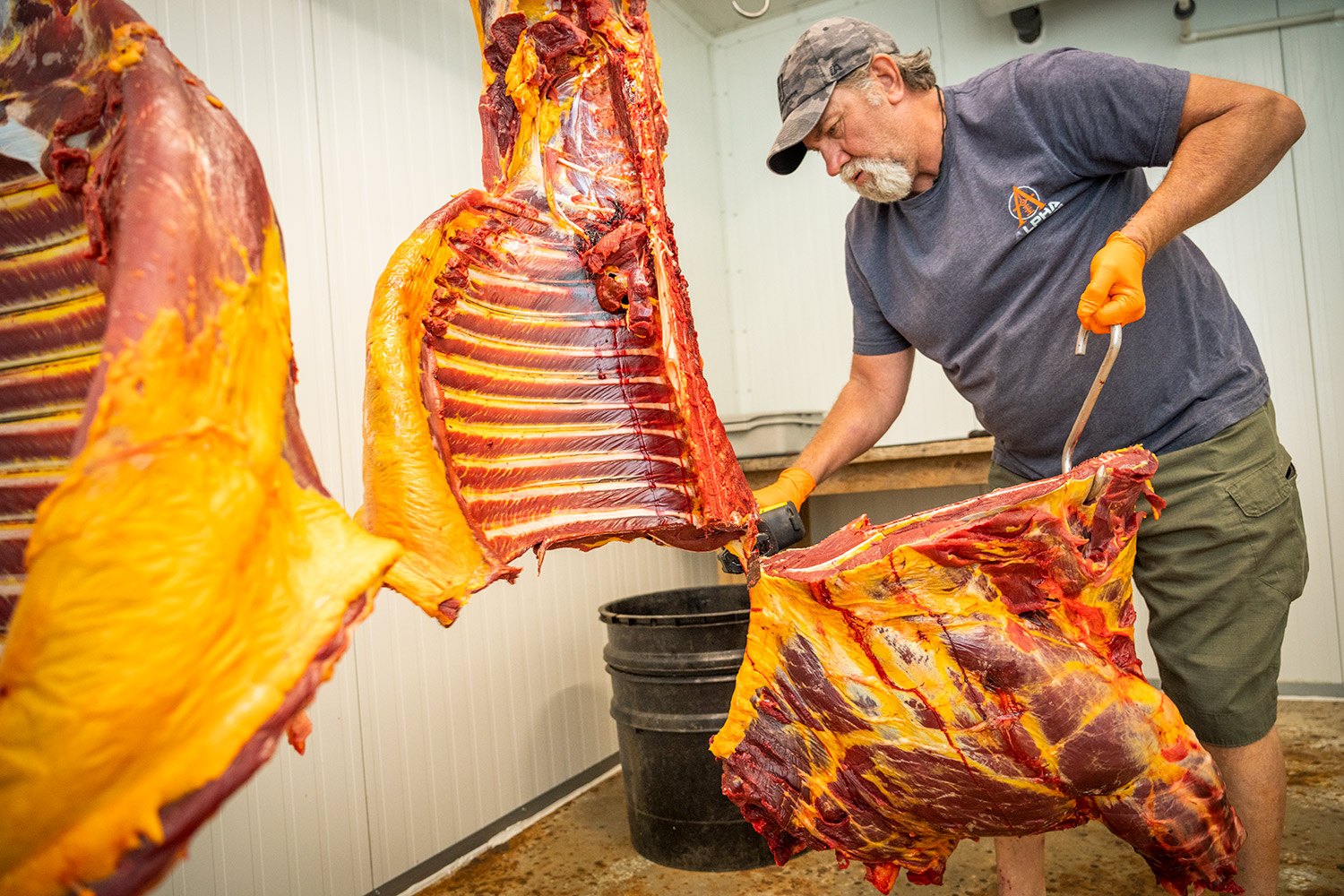
From Hunting Guide to Herdsman
“You ever tried zebra before?” asks Robert Martin, who everyone just calls Uncle Bobby. He smiles when I tell him I haven’t. “You’re in for a treat.”
Wallace’s right-hand man and the only employee who lives on the ranch full time, Martin is in the middle of butchering the Grant’s zebra that a client, Steve Beatte, killed this morning. After severing a chunk of rib with a Sawzall, Martin grabs a sharp knife to cut out a few tomahawk steaks. The hide of the blond-maned stallion lies on the floor of the walk-in cooler, rinsed and ready for a trip to the taxidermist.
Josh Risner, Wallace’s lead guide, stands outside under the roof of the skinning shed. Built like an ox, the back of his neck is sunburned from ranch work, his arms covered in tattoos. He can throw deer over his shoulder like bags of corn, and he and Martin once set a ranch record by skinning 18 animals in 24 hours.
While Martin trims a tenderloin, they both get a text from Wallace with a GPS pin: “Ram down. Nala to me.” Before Martin can get his gloves off, Risner replies. He loads Nala, Wallace’s tracking dog, into a buggy and drives off to help find the downed sheep.
Two rigs come back an hour later. A dead ram lies on a rack mounted to the Jeep’s front bumper. It’s an old Transcaspian urial, native to the mountains of Uzbekistan, Kazakhstan, and northern Iran. When Risner puts a tape to its horns, we see its upper gums are cut and swollen from rubbing against the few lower teeth it had left.
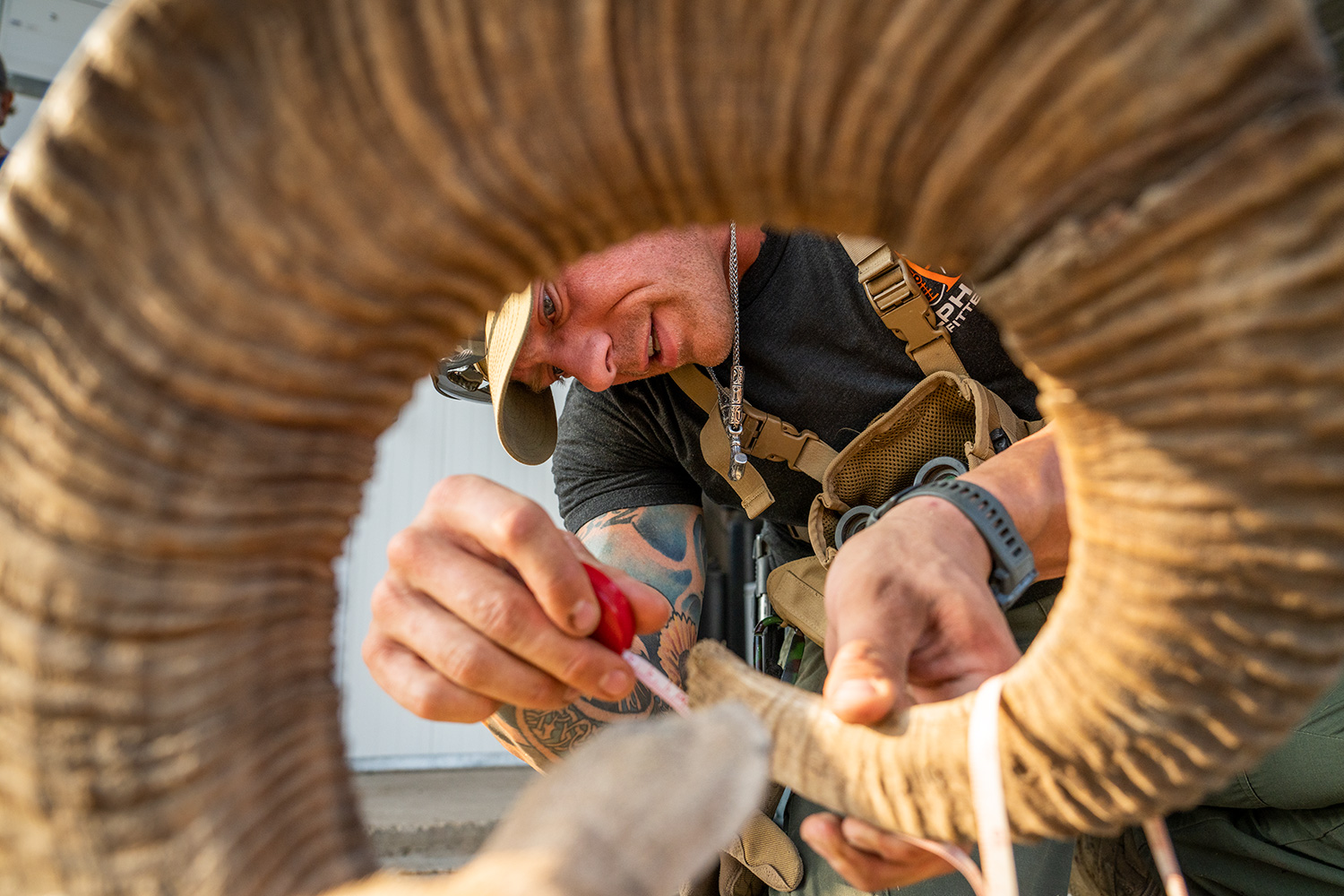
The zebra and the ram aren’t the first critters Beatte and Wallace have killed together, and they won’t be the last. That evening, Beatte will shoot an axis buck with just a shred of velvet hanging from the base of its antlers. The following day, he’ll take what could be the highest-scoring bongo ever killed with a handgun. A striped, forest-dwelling antelope native to sub-Saharan Africa, the bongo will cost Beatte roughly $50,000, or about 10 times as much as the axis. But that’s just part of the game down here, and Wallace knows exactly how to play it.
Wearing tactical boots, cargo pants, a tucked-in T-shirt, and a cap, Wallace looks like former military. Serving in his own way, he forged his identity and moral compass in a firehouse, where he followed in his father’s footsteps and still works today. But underneath an exterior hardened by West Texas wildfires and trauma care, Wallace’s affable nature shines through. He smiles often and easily, especially when he talks about BB, the 11-day-old markhor kid he carries around in his arms.
“You should have seen me trying to get her to take the bottle,” Wallace tells me, explaining how he nursed the goat back to health after its mother died giving birth to triplets. “I’d have to sit down and take my shirt off, and she’d nose around my chest for a while. Eventually she’d get up near my armpit and I would slip the nipple through.”
Also known as “screw-horned goats,” markhor are native to the Himalayas, where they spend most of their lives above the treeline. They’re incredibly agile climbers. They’re also increasingly rare in the wild.
The 41-year-old now breeds and raises the goats on his home property near Luling. It’s a new phase for Wallace, who started guiding hunters on private ranches 17 years ago. Working his way up from whitetail and aoudad hunts, he got to know other landowners and exotic-animal brokers. It wasn’t long before he was traveling the state, taking eager clients to whichever ranch held the next critter on their list.
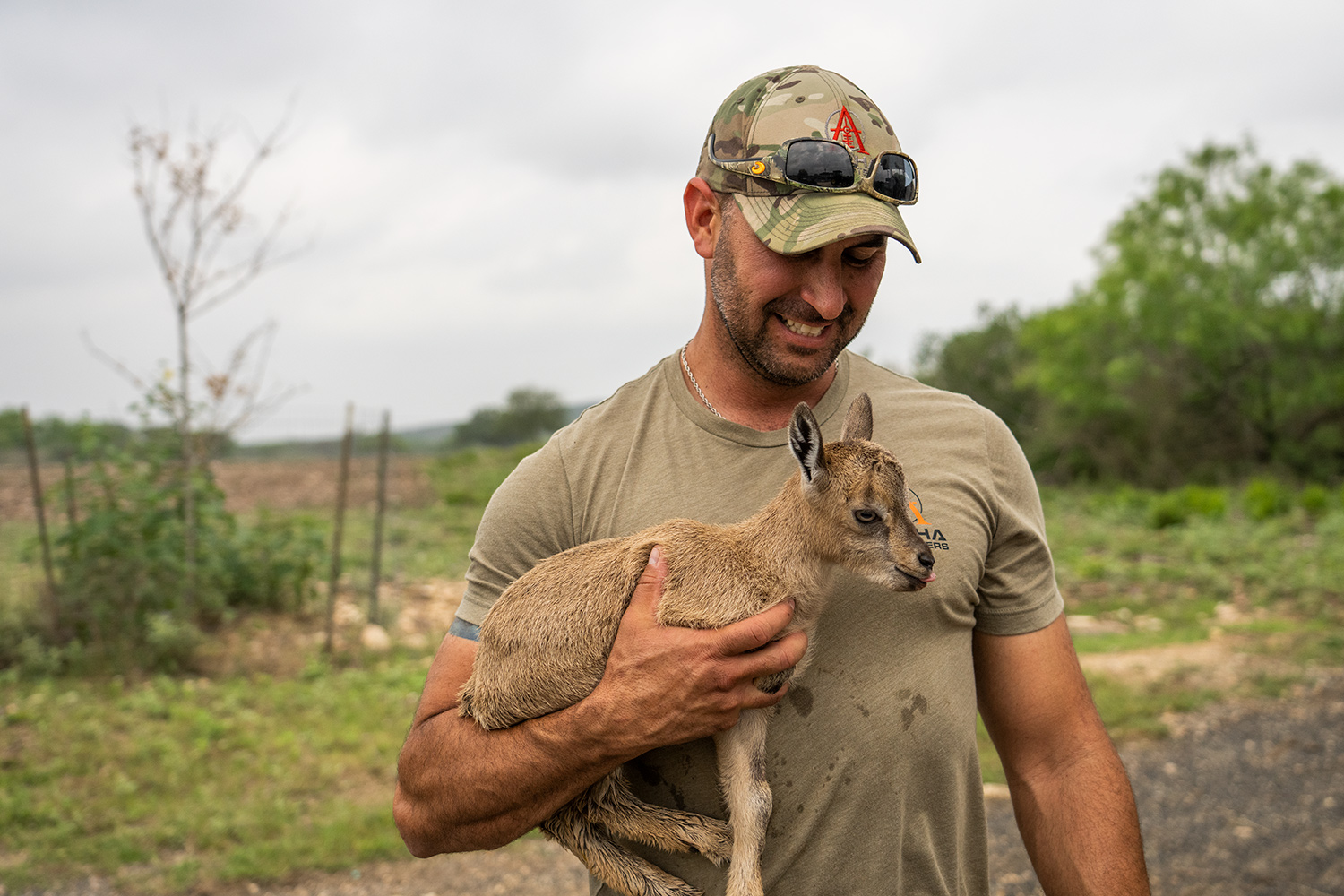
“Eventually, I had to branch out,” Wallace says. “My reputation kind of grew, and other ranchers started contacting me, asking, ‘Hey, how can I get you to come sell animals on my place?’”
This brought him and his outfitting business to Salt Creek, where he’s grown the hunting program while establishing a breeding operation. They primarily breed markhor, fallow deer, kangaroos, and Nubian ibex, but also have a few African species like kudu, bongo, nyala, and sitatunga antelope.
The transition from hunting guide to herdsman seems natural for Wallace. Long before he was a professional hunter and a ranch manager, he was an FFA kid who raised hogs and goats. He was also obsessed with the movie Hatari!, in which John Wayne plays a wildlife trapper in Africa named Sean Mercer.
“My best friend and I, we’d go out to his ranch, jump around the picnic tables, and yell ‘Let out the rhinos!’” Wallace laughs. “And I told him one day when we were 7 or 8: ‘I’m gonna have my own ranch someday and do this just like John Wayne.’”
He might be in Texas, but for all intents and purposes, Wallace is a modern-day Mercer. And getting into some of his wilder animal-capture stories, it’s clear he has the bumps and bruises to prove it.
“I’ve been gored, kicked, and had my knee dislocated more than once,” Wallace says. “I’ve ridden eland bulls through this brush because they weren’t as asleep as I thought they were.
“And that’s nothing. There are guys out here who ride around on four-wheelers with lassos. They’ll ride up beside the animals, rope ’em and bail off. Then they’ll grab their tails, sweep a leg, dive on ’em and hogtie ’em. I’m talking real cowboy stuff.”
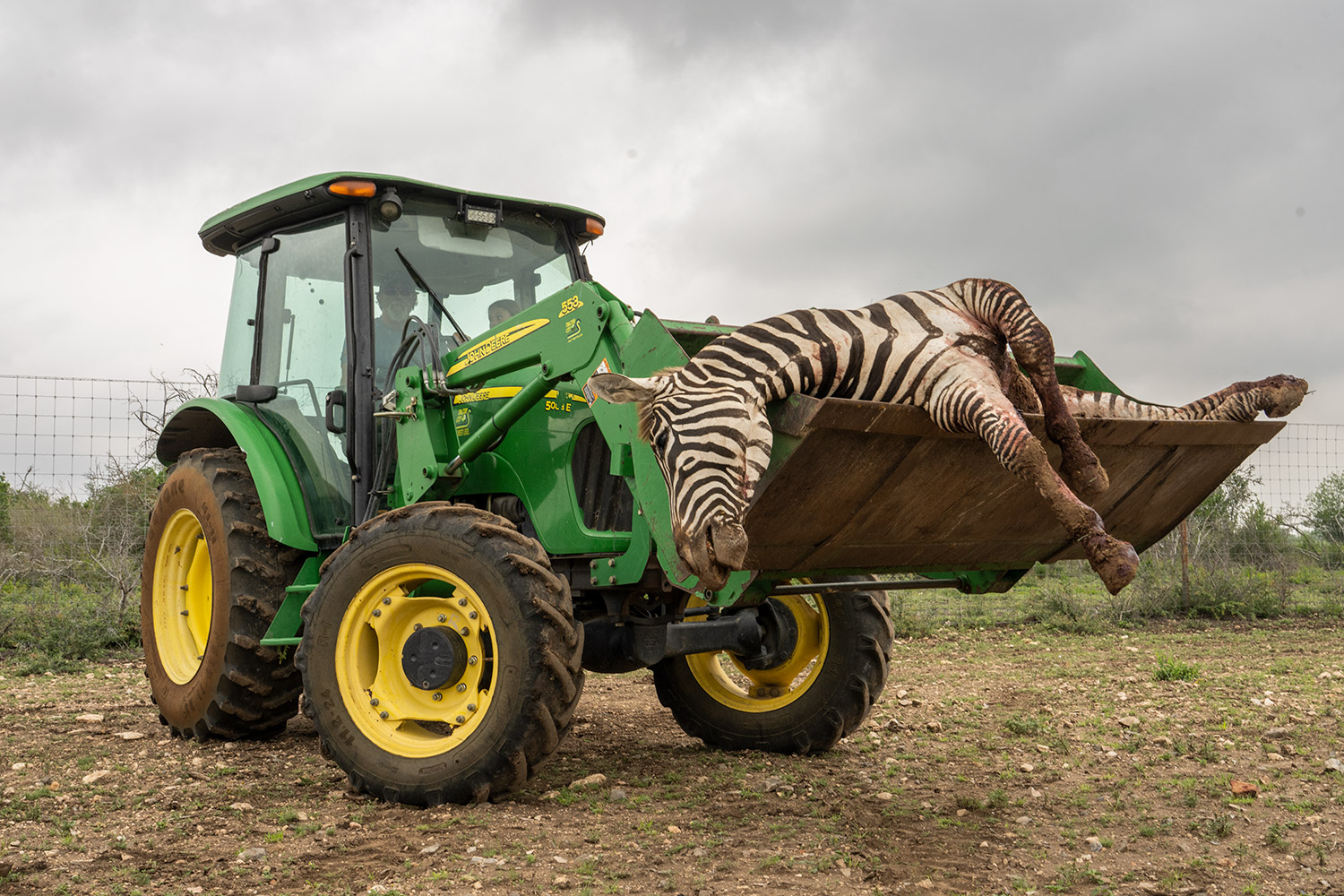
Striped Horse for Supper
That night, after photographing Beatte’s axis buck, we all sit down at the ranch house for dinner. Our plates are crammed with giant wagyu steaks, homemade salsa, potatoes, and zebra tenderloin. And while I’ve never considered myself a horse-meat evangelist, I will say that Uncle Bobby was right. Grilled rare over an open mesquite fire, the zebra blows the beefsteak right out of the water.
What’s harder to swallow is how the state’s exotic-hunting industry is built on the premise of treating an animal like wildlife while using it as livestock.
Keeping these thoughts entirely to myself, I hear about a nearby rancher who was nearly gored to death by a warthog in a breeding pen. Wallace tells stories from Africa, like the time he was stalked by a leopard while blowgun hunting in Namibia. We talk about the first deer Landon ever killed — she was with Wallace at the time — and the broken-horned blackbuck that got away that afternoon.
Read Next: Cape Fear: Hunting Buffalo in the Matetsi Safari Area of Zimbabwe
At some point the conversation drifts from big exotic critters to the long-gone megafauna painted on cave walls. Someone mentions the researchers who are trying to resurrect the woolly mammoth. The company plans to use preserved DNA to grow a woolly mammoth embryo and implant it in an African elephant. The laboratory, of course, is based in Texas.
“You know, I think I know a guy who would buy a woolly mammoth hunt,” Wallace jokes.
But I get the feeling he’s dead serious.
This story was first published on June 3, 2023.

